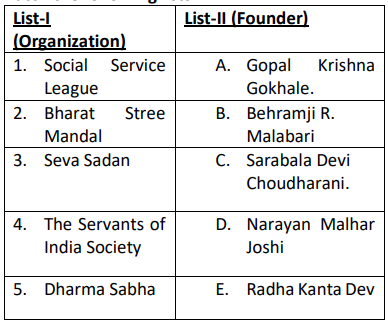Question
Statements: J @ K, K $ L, L & M, M % N
Conclusions: I. K @ M II. N & J In the following question, the symbols $, @, & , % and # are used with the following meanings as illustrated below: ‘P $ Q’ means ‘P is neither greater than nor smaller to Q’ ‘P @ Q’ means ‘P is neither greater than nor equal to Q ‘P & Q’ means ‘P is neither smaller than nor equal to Q ‘P % Q’ means ‘P is not smaller than Q’ ‘P # Q’ means ‘P is not greater than Q Now, in each of the following question assuming the given statement to be true, find which of the two conclusions I and II given below them is / are definitely true. Give answer.Solution
Decoded statement: J < K, K = L, L > M, M ≥ N Decoded conclusion M. K < M II. N > J Combined Inequalities: J < K = L > M ≥ N J < K = L > M ≥ N K > M. Hence conclusion M is not true. J < K = L > M ≥ N No relationship can be established between N and J. Hence conclusion II is not true.
The 'Dandi March' was associated with which movement?
What does the term ‘chatuspathis’ and ‘tols’ refer to?
The system of "Communal Electorate" was first introduced in India by which British Act?
Which notable figure did not play a role in the establishment of the U.P. Kisan Sabha in February 1918?
Who among the following is known for his work on Medicine during the Gupta period?
Match the following lists:

Select the correct answer f...
Which among the following relates to caste movement in India?
1. Ezhava movement.
2. Nadar movement.
3. Mahar Movement.
...Who was the last person to be initiated into his religion by Gautam Buddha?
Which player has made the record of most sixes in international cricket
Which emperor wrote the Sanskrit play 'Nagananda'?


